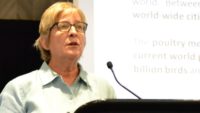USPOULTRY’s 2023 Live Production, Welfare and Biosecurity Seminar provided attendees with perspectives on biosecurity and safeguarding flock health, particularly in the light of the ongoing threat presented by highly pathogenic avian influenza (HPAI). Additional topics covered water sanitation, on-farm food safety testing, antimicrobial stewardship, biosecurity audits and more.
Continuing the HPAI theme, Joseph Churilla, wildlife biologist at the U.S. Department of Agriculture APHIS Wildlife Services, gave an update on the efforts being made to prevent flock infection. He explained that Wildlife Services works with airports in hazard mitigation and that many of the strategies applied to bird strike prevention also apply to biosecurity at poultry farms. He noted that while it is not possible to control what flies over a farm, there are factors that can be controlled to prevent infection.
Dr. Casey Ritz, professor and extension poultry coordinator at the University of Georgia, discussed the importance of litter management in disease prevention and flock health. Four principles of disease-preventing litter management were provided, including removing dead birds, controlling moisture, controlling ammonia and suppressing pathogens. He noted that litter management is a continuous process and that pathogens can carry over from flock to flock, leading to repeat disease outbreaks. Methods for treating litter, including flaming, shallow fermentation and windrowing, were discussed, along with their various benefits and ability to destroy pathogens.
Dr. Lilong Chai, assistant professor and engineering specialist in the Department of Poultry Science at the University of Georgia, provided an update on precision farming technologies for poultry and egg producers. He discussed artificial intelligence (AI) technology and machine vision combining to allow monitoring of house conditions as well as bird behaviors and health conditions.
Dr. Maxcy Nolan III, consultant with the NIPCAM Group, presented on mitigating pest pressures in poultry. Prevention strategies were discussed, and common factors included biosecurity measures to exclude the pests from the facility. Prevention and early action were highlighted as the most effective means to mitigate pest pressures. Control methods, including rodenticides and their regulatory requirements, were also discussed.
Source: U.S. Poultry & Egg Association

.jpg?height=200&t=1666223297&width=200)


Report Abusive Comment